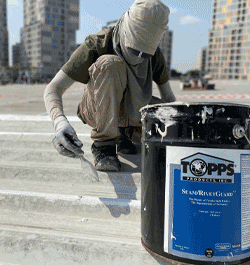UP TO THE MINUTE
Location Matters – Re-roofing Your Home With Environment in Mind

By Metal Roofing Alliance.
Do you know what to look for in a roof based on your geographical region and climate? This guide has the answers for you!
Editor’s note: The Metal Roofing Alliance (MRA) has organized the Residential Metal Roofing Buyer’s Guide to help homeowners learn about the basics of roofing. This article discusses the question of, “Does where I live matter when re-roofing?” using a passage from the guide.
Making the decision to re-roof your home is a big deal, and it can be a big investment both time and finance wise. The Metal Roofing Alliance (MRA) is dedicated to educating homeowners on the basic signs of roof aging, damage and decay so that they are aware of when it is time to make the big leap and start the re-roofing process. This article, a passage in the informative Residential Metal Roofing Buyer’s Guide, will walk you through the steps of identifying the key signs of a roof’s expiration and how your geographical location plays a role in what roof is best for you.
One of your first considerations when re-roofing your home should be where you live. Why? Because the area in which you live can have a big impact on your roof and its potential lifespan. Understanding how your home’s location could impact the roof will go a long way toward ensuring you select and install a roof that can exceed your performance expectations.
Here are some important regional considerations that should impact your roof selection process.
Hurricanes and high winds
Consider the following if you live in an area that experiences hurricanes, tornadoes or high winds:
- Wind speeds: which roof options (systems) are tested and proven to withstand high winds?
- Performance ratings: what roofing products are rated to withstand the winds that could befall my area? (NOTE: there is a formal, recognized rating system in place for high winds)
- Building codes: what do local building codes require as it relates to high winds?
- Insurance: which roofing materials are rated to meet/exceed insurance company policy requirements?
Wildfires
Consider the following if you live in an area where wildfires are a possibility:
- Fire insurance: what roofing materials are tested and proven to be fire resistant?
- Performance ratings: what roofing materials are rated to withstand high heat such as from direct flame or embers? (NOTE: there is a formal, recognized rating system in place for fire resistance)
- Building codes: what building code requirements related to flames or embers exist in my area and what roofing materials can meet those codes?
- Insurance: which roofing materials are rated to meet/exceed insurance company policy requirements?
Snow and ice
Consider the following if you live in an area where that frequently experiences snow and ice:
- Snow loads: what roofing options can support heavy snow loads (weight)?
- Snow shedding: what roofing materials might assist with shedding snow, making the process easier and/or safer?
- Snow guards: what snow guard options are available (and effective) for the roofing materials I am considering?
- Ice damming: what roofing options will minimize or alleviate ice damming?
Hail
Consider the following if you live in an area that experiences large and/or frequent hail:
- Dent resistant: what roofing materials are tested and proven to be dent resistant?
- Roof substructure: in hail prone areas, MRA recommends installing metal roofing over sheeting and not over purlins or over existing roofing materials
- Performance ratings: which roofing materials are rated to withstand hail, both larger in size and at higher rates of speed? (NOTE: there is a formal, recognized rating system in place for hail)
- Building codes: what building code requirements related to hail exist in my area and what roofing materials can meet those codes?
- Insurance: which roofing materials are rated to meet/exceed insurance company policy requirements? Be sure to clarify with your insurance company what types of hail damage would be covered and what would not, as well as specific installation requirements they may have for the roofing materials
Other regional considerations
Consider the following:
- Hot climates: what roofing products can repel heat and minimize cooling loads (the need for air conditioning)?
- Cold climates: what roofing products can hold heat and minimize heating loads?
- Solar: which roofing products work best with solar panels and attachments? What roofing products will last as long or longer than the solar panels themselves (so panel warranties are not voided by removal/replacement)?
- Difficult to reach: what roofing products have the longest lifespan in order to avoid replacement in difficult locations (safety)?
Important takeaways
- Performance ratings: How your roof system performs in severe weather can be vital in protecting your home. Performance ratings for roofing products exist for that very reason… to help ensure your roof can withstand whatever Mother Nature throws its way. To learn more about the various performance ratings related to residential roofing, please contact the MRA at support@metalroofing.com.
- Standards & specifications: In addition, applicable building codes, standards and specifications may exist in your area. Failure to follow these accepted procedures and methods can result in lawsuits, inspection failures, and added project costs. Most codes, standards, and specifications are designed to ensure quality and safety in the construction, and specific requirements in energy efficiency. Knowing what is required and/or truly needed for your area prior to selecting a roof system is a critical step toward ensuring the longevity and performance of your roof.
Original article source: MRA
Learn more about Metal Roofing Alliance (MRA) in their Coffee Shop Directory or visit www.metalroofing.com.
About The Metal Roofing Alliance (MRA)
Representing the residential metal roofing industry in the United States and Canada, the Metal Roofing Alliance (MRA) was formed to help educate consumers about the many benefits of metal roofing. For more information about MRA membership, residential metal roofing resources and tools, visit MRA at www.metalroofing.com.



















Comments
Leave a Reply
Have an account? Login to leave a comment!
Sign In